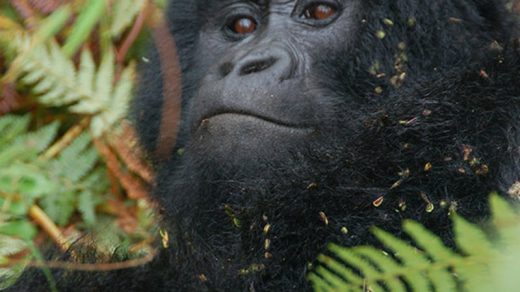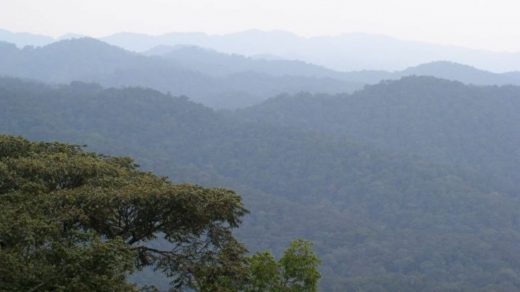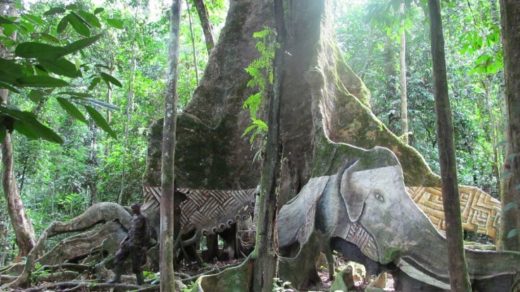The mountain gorilla (Gorilla beringei beringei) is one of two subspecies of the eastern gorilla; with the other subspecies being Grauer´s gorilla (Gorilla beringei graueri).
The mountain gorilla inhabit volcanic slopes in Rwanda, Uganda and eastern Democratic Republic of Congo (DRC). As of 2022, there are roughly 1,000 mountain gorillas left in the wild.
As of 2018, the mountain gorilla is listed as Endagered on the IUCN Red List.
The main NGO involved in mountain gorilla conservation is The International Gorilla Conservation Programme. It was established in 1991 as a joint effort of the African Wildlife Foundation, Fauna & Flora International, and WWF.
Distribution and habitat
The mountain gorillas are found in the Albertine Rift montane cloud forest, and most of the groups live on the slopes of the three dormant volcanoes Karisimbi, Mikeno and Visoke.
They have been observed from roughly 2,200 metres above sea level and up to approximately 4,300 meters. The habitat where the mountain gorillas live is montane cloud forest, which is often cloudy and misty. Even though it is in the tropics, it can be quite chilly at such high altitudes.
The two populations of mountain gorilla
There are two populations of mountain gorilla:
- One population lives in the Virunga volcanic slopes in Central Africa. They are found in the national parks Mgahinga Gorilla National Park in south-western Ugana, Volcanoes National Park in north-western Rwanda, and Virunga National Park in the eastern Democratic Republic of Congo (DRC).
- One population is found within the Bwindi Impenetrable National Park in south-western Uganda. Some research indicate that this population might actually be another subspecies.
Evolution
The mountain gorillas have been isolated from the eastern lowland gorillas for an estimated 10,000 years. Both subspecies hail from a population of gorilla that separated from the western gorillas approximately 1.2 – 3 million years ago.
Conservation impact
Conservation efforts in the 21st century has increased the total population of wild mountain gorillas in Virungas and Bwindi, but the subspecies is still considered Endangered by the IUCN. The total wild population is now slightly above 1,000 individuals.
In December 2010, Virunga National Park announced that the number of mountain gorillas in the tri-national forested area (of which Virunga is one part) had increased by 26.3% during the last seven years.
- Virunga
The Virunga mountain gorilla population was down to 254 individuals in 1981. By 1989, it had increased to 320 individuals, and the 2010 census reported 480 mountain gorillas living in Virunga.
- Bwindi
At the 2006 census, 340 mountain gorillas lived in Bwindi, which was a 6% increase from 2002. In 1997, the Bwindi population was comprised of 320 individuals.
Threats, effects and conservation efforts
Poaching
- Mountain gorillas are targeted by poachers who kill them to sell their body parts, e.g. their hands as ash trays.
- Infants are abducted for the illegal pet trade or to be sold illegally to zoos. This often result in the killing of adult mountain gorillas who try to protect the infant.
- Mountain gorillas are killed or maimed by traps set for other animals.
Conservation efforts include having armed guards patrolling areas where the mountain gorillas live, and actively looking for and removing traps. Guards employeed by the Karisoke Research Centre in the Volcanoes National Park in Rwanda remove approximately 1,ooo snares each year. The centre also runs a facility for young gorillas rescued from poachers.
Programs are in place that work with local communities to increase access to other forms of income, thus reducing the temptation to poach.
Habitat loss
Expanding human settlements destroys gorilla habitats, and the fragmentation of the forested areas makes surviving gorilla groups isolated from each other, which in turn reduces the genetic diversity.
National Parks and other protected areas have been expanded to combat this, and there is also an increased focus on linking protected areas with each other to work against isolation.
There is a strong need to work with local human communities to provide alternative sources of income and boost support for conservation efforts. One example is how the Karisoke Research Centre work with local communities in several different ways. Among other things, they supply primary school pupils with books and other materials, run conservation programs for secondary schools, hire local park staff and train them, provide biodiversity training for local conservation groups. The centre also provides field courses and internships for Rwandan college students from various parts of Rwanda, to promote a more widespread support for conservation efforts in Rwanda.
In Bwindi, local communities have been involved in park management to reduce the threat from deliberately set wildfires. Controlled harvesting of certain resources within the park is permitted, local communities recieve some revenue from eco tourism, and a trust fund has been established for community development. Surveys show that as local communities become more involved, and when the national park provides job and income opportunties to locals, an proportion of the locals being in favour of the national park and of protecting the gorillas increases.
Pathogens
Tourists and other humans being near the gorillas transmitt dangerous pathogens. A lot of pathogens (such as bacteria and viruses) that can infect humans can also infect gorillas, as we are so closely related. Domestic animals and livestock in the gorilla´s environment and also transmitt patogens to the apes.
Conservation efforts are currently focused on stricter rules for eco tourism, and more educational efforts for local communities to reduce the impact from domestic animals and livestock.
War and unrest
The mountain gorillas live in countries which have been, and still are, plagued by either war and or other violent forms of unrest.
- Refugees coming to protected areas will destroy gorilla habitat in order to set up settlements and farms. This does not only have a direct impact, it can also lead to uncontrolled wildfires as slash-and-burn is a common method for clearing land.
- Refugees in need of food will increase the demand for bush meat, including gorilla meat.
- Land mines placed in the forest (including on forest paths) kill and maime gorillas.
Habituation effects
According to computer modelling for Bwindi and Virungas, groups of gorillas that are habituated for research and ecotourism have higher population growth rates than unhabituated groups. In this context, habituation means that through repeated neutral exposure to researchers, eco tourists and park staff, the gorillas have become accustomed to humans being around and the gorillas behave normally in such situations.
Habituated gorillas can be more closely guarded by field staff, and they also recieve veterinary treatment for snare injuries, respiratory disease and other serious conditions.
Researchers recommend that some gorillas should remain unhabituated. One of the reasons is that the habituated populations might dwindle if a dangerous human pathogen is passed on to them.
Understanding gorilla taxonomy
In 1967, the taxonomist Colin Groves proposed that all gorillas were the same species, and that this species consisted of three subspecies: Western lowland gorilla (Gorilla gorilla gorilla), Eastern lowland gorilla (Gorilla gorilla grauer) and Mountain gorilla (Gorilla gorilla beringei).
After a review, The World Conservation Union changed the taxonomy in 2003, and divided gorillas into two species, with each species consisting of two subspecies.
Current taxonomy
Genus: Gorilla
Species:
- Gorilla gorilla (Western gorilla)
- Gorilla beringei (Eastern gorilla)
Subspecies:
-
-
- G. g. gorilla (Western lowland gorilla)
- G. g. diehli (Cross River gorilla)
- G. b. beringei (Mountain gorilla)
- G. b. graueri (Eastern lowland gorilla)
-


